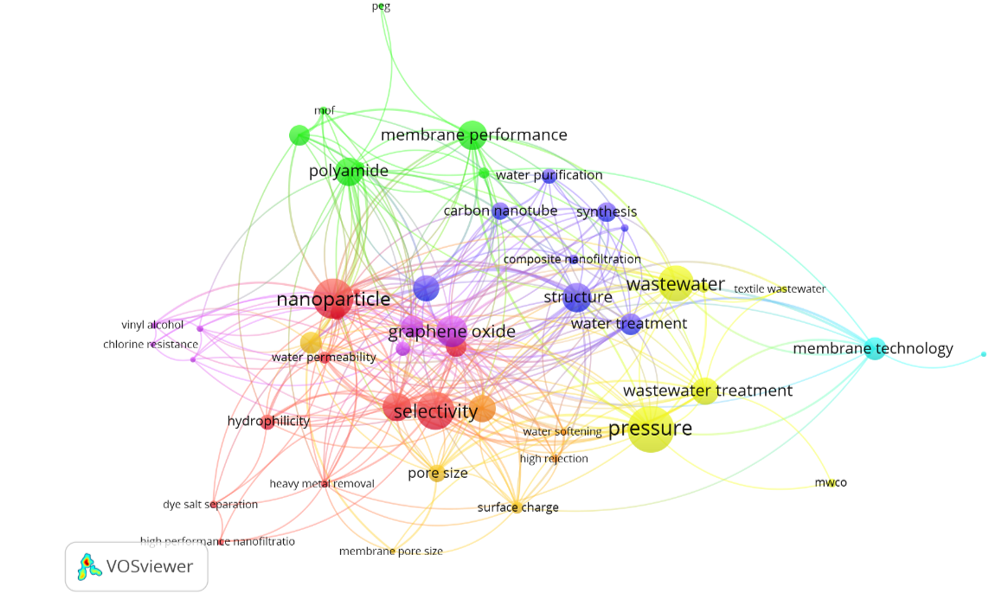Bibliometric Analysis for Research Trends Nanofiltration Membranes in The Past Decade to 2023
DOI:
https://doi.org/10.51264/inajl.v4i1.40Keywords:
Bibliometric, computational mapping analysis, Nanofiltration membrane, VOSViewerAbstract
Water treatment is an important part that has an impact on life, to understand the progress of nanofiltration membrane research literature related to this field was obtained from the Google Scholar database. Based on mapping and visualization software VOSviewer, the number of publications and groupings were calculated and analyzed. Research advances and trends in the field of nanofiltration membranes are summarized. The results of the study show that since 2013 the quantity of publications in this field has increased every year until 2020 then decreased in 2021 and then increased again in 2022. This field has received attention including its wide application in water treatment. Related studies have been published in the journal of Membrane Science and Desalination which is the authoritative journal in this field with the largest number of publications. According to the keyword network map of nanofiltration membranes there are 8 clusters, and this field can generally be divided into three research stages, namely synthesis, characterization, and performance testing. To achieve the goals of research development, it must be further deepened in future work. This article will provide a reference for researchers engaged in membrane technology and its applications.
References
Al Husaeni DF & Nandiyanto ABD. 2021. Bibliometric using vosviewer with publish or perish (using google scholar data): From step-by-step processing for users to the practical examples in the analysis of digital learning articles in pre and post covid-19 Pandemic. ASEAN Journal of Science and Engineering, 2(1), 19–46. https://doi.org/10.17509/ajse.v2i1.37368
Azizah NN, Maryanti R, & Nandiyanto ABD. 2021. How to search and manage references with a specific referencing style using google scholar: From step-by-step processing for users to the practical examples in the referencing education. Indonesian Journal of Multidiciplinary Research, 1(2), 267–294. https://doi.org/10.17509/ijomr.v1i2.37694
Bagheripour E, Moghadassi AR, Parvizian F, Hosseini SM, & Van der Bruggen B. 2019. Tailoring the separation performance and fouling reduction of PES based nanofiltration membrane by using a PVA/Fe3O4 coating layer. Chemical Engineering Research and Design, 144, 418–428. https://doi.org/10.1016/j.cherd.2019.02.028
Behdarvand F, Valamohammadi E, Tofighy MA, & Mohammadi T. 2021a. Polyvinyl alcohol/polyethersulfone thin-film nanocomposite membranes with carbon nanomaterials incorporated in substrate for water treatment. Journal of Environmental Chemical Engineering, 9(1), 104650. https://doi.org/10.1016/j.jece.2020.104650
Bet-Moushoul E, Mansourpanah Y, Farhadi K, & Tabatabaei M. 2016. TiO2 nanocomposite based polymeric membranes: A review on performance improvement for various applications in chemical engineering processes. Chemical Engineering Journal, 283, 29–46. https://doi.org/10.1016/j.cej.2015.06.124
Ding M, & Zeng H. 2022. A bibliometric analysis of research progress in sulfate-rich wastewater pollution control technology. Ecotoxicology and Environmental Safety, 238, 113626. https://doi.org/https://doi.org/10.1016/j.ecoenv.2022.113626
Ihsanullah. 2019. Carbon nanotube membranes for water purification: Developments, challenges, and prospects for the future. Separation and Purification Technology, 209, 307–337. https://doi.org/https://doi.org/10.1016/j.seppur.2018.07.043
Karimi A, Khataee A, Vatanpour V, & Safarpour M. 2019. High-flux PVDF mixed matrix membranes embedded with size-controlled ZIF-8 nanoparticles. Separation and Purification Technology, 229(July), 115838. https://doi.org/10.1016/j.seppur.2019.115838
Kusworo TD, Kumoro AC, Utomo DP, Kusumah FM, & Pratiwi MD. 2021. Performance of the Crosslinked PVA Coated PES-TiO2Nano Hybrid Membrane for the Treatment of Pretreated Natural Rubber Wastewater Involving Sequential Adsorption - Ozonation Processes. Journal of Environmental Chemical Engineering, 9(2), 104855. https://doi.org/10.1016/j.jece.2020.104855
Mao G, Hu H, Liu X, Crittenden J, & Huang N. 2021. A bibliometric analysis of industrial wastewater treatments from 1998 to 2019. Environmental Pollution, 275, 115785. https://doi.org/https://doi.org/10.1016/j.envpol.2020.115785
Park HM, Oh H, Jee KY, & Lee YT. 2020. Synthesis of PVDF/MWCNT nanocomplex microfiltration membrane via atom transfer radical addition (ATRA) with enhanced fouling performance. Separation and Purification Technology, 246, 116860. https://doi.org/10.1016/j.seppur.2020.116860
Plaza-Garrido A, Limaico M, & Villamar-Ayala CA. 2022. Influence of wastewater treatment technologies on virus removal under a bibliometric-statistical analysis. Journal of Water Process Engineering, 47, 102642. https://doi.org/https://doi.org/10.1016/j.jwpe.2022.102642
Thakur VK, & Voicu SI. 2016. Recent advances in cellulose and chitosan based membranes for water purification: A concise review. Carbohydrate Polymers, 146, 148–165. https://doi.org/10.1016/j.carbpol.2016.03.030
Wang W, Zhu L, Shan B, Xie C, Liu C, Cui F, & Li G. 2018. Preparation and characterization of SLS-CNT / PES ultra fi ltration membrane with antifouling and antibacterial properties. Journal of Membrane Science, 548, 459–469. https://doi.org/10.1016/j.memsci.2017.11.046
Yuan H, Wang Y, Cheng L, Liu W, Ren J, & Meng L. 2014. Improved antifouling property of poly(ether sulfone) ultrafiltration membrane through blending with poly(vinyl alcohol). Industrial and Engineering Chemistry Research, 53(48), 18549–18557. https://doi.org/10.1021/ie502797k

Downloads
Published
Issue
Section
License
Copyright (c) 2023 Yurin Karunia Apsha Albaina Iasya, Asep Bayu Dani Nandiyanto

This work is licensed under a Creative Commons Attribution-ShareAlike 4.0 International License.






